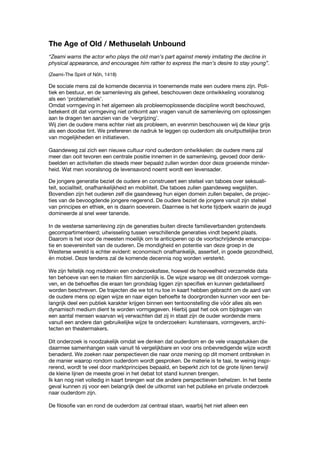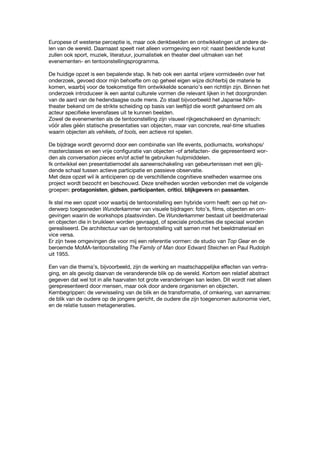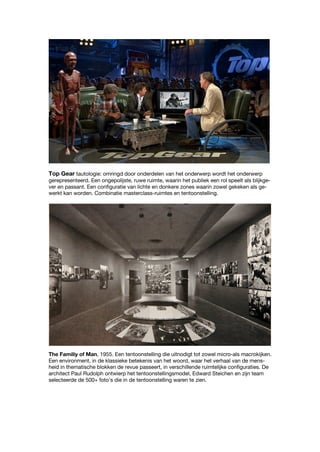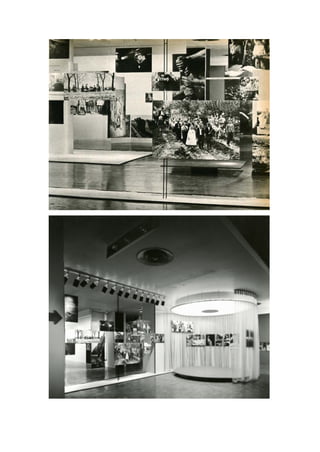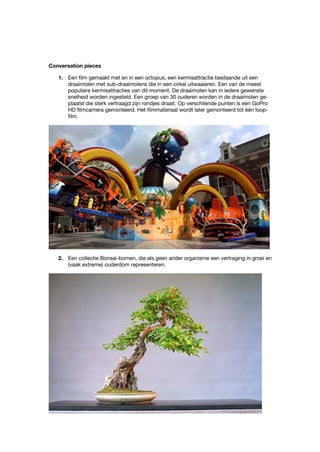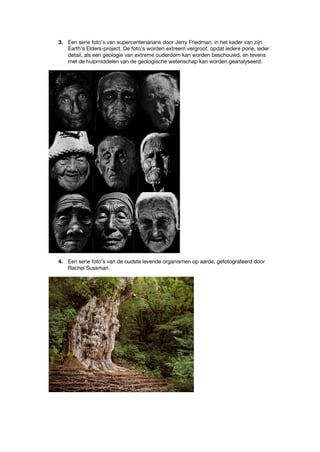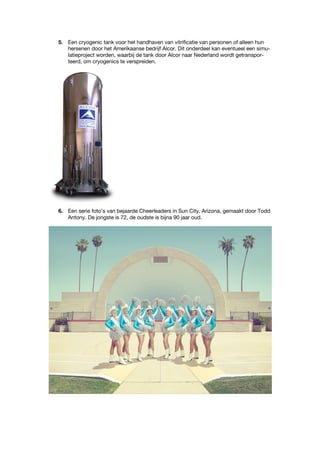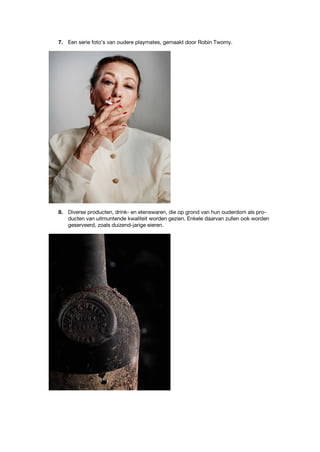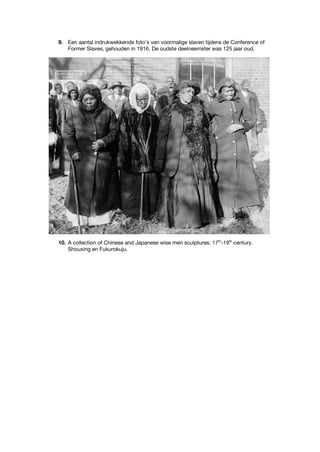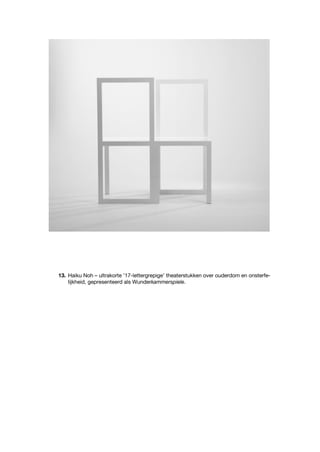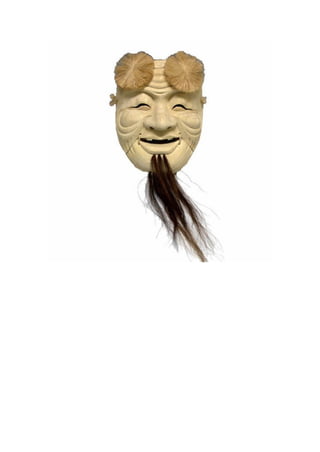The Age of Old-omschrijving.pdf
- 1. The Age of Old / Methuselah Unbound ŌĆ£Zeami warns the actor who plays the old manŌĆÖs part against merely imitating the decline in physical appearance, and encourages him rather to express the manŌĆÖs desire to stay youngŌĆØ. (Zeami-The Spirit of N├┤h, 1418) De sociale mens zal de komende decennia in toenemende mate een oudere mens zijn. Poli- tiek en bestuur, en de samenleving als geheel, beschouwen deze ontwikkeling vooralsnog als een ŌĆśproblematiekŌĆÖ. Omdat vormgeving in het algemeen als probleemoplossende discipline wordt beschouwd, betekent dit dat vormgeving niet ontkomt aan vragen vanuit de samenleving om oplossingen aan te dragen ten aanzien van de ŌĆśvergrijzingŌĆÖ. Wij zien de oudere mens echter niet als probleem, en evenmin beschouwen wij de kleur grijs als een doodse tint. We prefereren de nadruk te leggen op ouderdom als onuitputtelijke bron van mogelijkheden en initiatieven. Gaandeweg zal zich een nieuwe cultuur rond ouderdom ontwikkelen: de oudere mens zal meer dan ooit tevoren een centrale positie innemen in de samenleving, gevoed door denk- beelden en activiteiten die steeds meer bepaald zullen worden door deze groeiende minder- heid. Wat men vooralsnog de levensavond noemt wordt een levensader. De jongere generatie beziet de oudere en construeert een stelsel van taboes over seksuali- teit, socialiteit, onafhankelijkheid en mobiliteit. Die taboes zullen gaandeweg wegslijten. Bovendien zijn het ouderen zelf die gaandeweg hun eigen domein zullen bepalen, de projec- ties van de bevoogdende jongere negerend. De oudere beziet de jongere vanuit zijn stelsel van principes en ethiek, en is daarin soeverein. Daarmee is het korte tijdperk waarin de jeugd domineerde al snel weer tanende. In de westerse samenleving zijn de generaties buiten directe familieverbanden grotendeels gecompartimenteerd; uitwisseling tussen verschillende generaties vindt beperkt plaats. Daarom is het voor de meesten moeilijk om te anticiperen op de voortschrijdende emancipa- tie en soevereiniteit van de ouderen. De mondigheid en potentie van deze groep in de Westerse wereld is echter evident: economisch onafhankelijk, assertief, in goede gezondheid, ├®n mobiel. Deze tendens zal de komende decennia nog worden versterkt. We zijn feitelijk nog middenin een onderzoeksfase, hoewel de hoeveelheid verzamelde data ten behoeve van een te maken film aanzienlijk is. De wijze waarop we dit onderzoek vormge- ven, en de behoeftes die eraan ten grondslag liggen zijn specifiek en kunnen gedetailleerd worden beschreven. De trajecten die we tot nu toe in kaart hebben gebracht om de aard van de oudere mens op eigen wijze en naar eigen behoefte te doorgronden kunnen voor een be- langrijk deel een publiek karakter krijgen binnen een tentoonstelling die v├│├│r alles als een dynamisch medium dient te worden vormgegeven. Hierbij gaat het ook om bijdragen van een aantal mensen waarvan wij verwachten dat zij in staat zijn de ouder wordende mens vanuit een andere dan gebruikelijke wijze te onderzoeken: kunstenaars, vormgevers, archi- tecten en theatermakers. Dit onderzoek is noodzakelijk omdat we denken dat ouderdom en de vele vraagstukken die daarmee samenhangen vaak vanuit t├® vergelijkbare en voor ons onbevredigende wijze wordt benaderd. We zoeken naar perspectieven die naar onze mening op dit moment ontbreken in de manier waarop rondom ouderdom wordt gesproken. De materie is te taai, te weinig inspi- rerend, wordt te veel door marktprincipes bepaald, en beperkt zich tot de grote lijnen terwijl de kleine lijnen de meeste groei in het debat tot stand kunnen brengen. Ik kan nog niet volledig in kaart brengen wat die andere perspectieven behelzen. In het beste geval kunnen zij voor een belangrijk deel de uitkomst van het publieke en private onderzoek naar ouderdom zijn. De filosofie van en rond de ouderdom zal centraal staan, waarbij het niet alleen een
- 2. Europese of westerse perceptie is, maar ook denkbeelden en ontwikkelingen uit andere de- len van de wereld. Daarnaast speelt niet alleen vormgeving een rol: naast beeldende kunst zullen ook sport, muziek, literatuur, journalistiek en theater deel uitmaken van het evenementen- en tentoonstellingsprogramma. De huidige opzet is een bepalende stap. Ik heb ook een aantal vrijere vormidee├½n over het onderzoek, gevoed door mijn behoefte om op geheel eigen wijze dichterbij de materie te komen, waarbij voor de toekomstige film ontwikkelde scenarioŌĆÖs een richtlijn zijn. Binnen het onderzoek introduceer ik een aantal culturele vormen die relevant lijken in het doorgronden van de aard van de hedendaagse oude mens. Zo staat bijvoorbeeld het Japanse N├┤h- theater bekend om de strikte scheiding op basis van leeftijd die wordt gehanteerd om als acteur specifieke levensfases uit te kunnen beelden. Zowel de evenementen als de tentoonstelling zijn visueel rijkgeschakeerd en dynamisch: v├│├│r alles g├®├®n statische presentaties van objecten, maar van concrete, real-time situaties waarin objecten als vehikels, of tools, een actieve rol spelen. De bijdrage wordt gevormd door een combinatie van life events, podiumacts, workshops/ masterclasses en een vrije configuratie van objecten -of artefacten- die gepresenteerd wor- den als conversation pieces en/of actief te gebruiken hulpmiddelen. Ik ontwikkel een presentatiemodel als aaneenschakeling van gebeurtenissen met een glij- dende schaal tussen actieve participatie en passieve observatie. Met deze opzet wil ik anticiperen op de verschillende cognitieve snelheden waarmee ons project wordt bezocht en beschouwd. Deze snelheden worden verbonden met de volgende groepen: protagonisten, gidsen, participanten, critici, blijkgevers en passanten. Ik stel me een opzet voor waarbij de tentoonstelling een hybride vorm heeft: een op het on- derwerp toegesneden Wunderkammer van visuele bijdragen: fotoŌĆÖs, films, objecten en om- gevingen waarin de workshops plaatsvinden. De Wunderkammer bestaat uit beeldmateriaal en objecten die in bruikleen worden gevraagd, of speciale producties die speciaal worden gerealiseerd. De architectuur van de tentoonstelling valt samen met het beeldmateriaal en vice versa. Er zijn twee omgevingen die voor mij een referentie vormen: de studio van Top Gear en de beroemde MoMA-tentoonstelling The Family of Man door Edward Steichen en Paul Rudolph uit 1955. Een van die themaŌĆÖs, bijvoorbeeld, zijn de werking en maatschappelijke effecten van vertra- ging, en als gevolg daarvan de veranderende blik op de wereld. Kortom een relatief abstract gegeven dat wel tot in alle haarvaten tot grote veranderingen kan leiden. Dit wordt niet alleen gerepresenteerd door mensen, maar ook door andere organismen en objecten. Kernbegrippen: de verwisseling van de blik en de transformatie, of omkering, van aannames: de blik van de oudere op de jongere gericht, de oudere die zijn toegenomen autonomie viert, en de relatie tussen metageneraties.
- 3. Top Gear tautologie: omringd door onderdelen van het onderwerp wordt het onderwerp gerepresenteerd. Een ongepolijste, ruwe ruimte, waarin het publiek een rol speelt als blijkge- ver en passant. Een configuratie van lichte en donkere zones waarin zowel gekeken als ge- werkt kan worden. Combinatie masterclass-ruimtes en tentoonstelling. The Familiy of Man, 1955. Een tentoonstelling die uitnodigt tot zowel micro-als macrokijken. Een environment, in de klassieke betekenis van het woord, waar het verhaal van de mens- heid in thematische blokken de revue passeert, in verschillende ruimtelijke configuraties. De architect Paul Rudolph ontwierp het tentoonstellingsmodel, Edward Steichen en zijn team selecteerde de 500+ fotoŌĆÖs die in de tentoonstelling waren te zien.
- 6. Conversation pieces 1. Een film gemaakt met en in een octopus, een kermisattractie bestaande uit een draaimolen met sub-draaimolens die in een cirkel uitwaaieren. Een van de meest populaire kermisattracties van dit moment. De draaimolen kan in iedere gewenste snelheid worden ingesteld. Een groep van 30 ouderen worden in de draaimolen ge- plaatst die sterk vertraagd zijn rondjes draait. Op verschilende punten is een GoPro HD filmcamera gemonteerd. Het filmmateriaal wordt later gemonteerd tot ├®├®n loop- film. 2. Een collectie Bonsai-bomen, die als geen ander organisme een vertraging in groei en (vaak extreme) ouderdom representeren.
- 7. 3. Een serie fotoŌĆÖs van supercentenarians door Jerry Friedman, in het kader van zijn EarthŌĆÖs Elders-project. De fotoŌĆÖs worden extreem vergroot, opdat iedere porie, ieder detail, als een geologie van extreme ouderdom kan worden beschouwd, en tevens met de hulpmiddelen van de geologische wetenschap kan worden geanalyseerd. 4. Een serie fotoŌĆÖs van de oudste levende organismen op aarde, gefotografeerd door Rachel Sussman.
- 8. 5. Een cryogenic tank voor het handhaven van vitrificatie van personen of alleen hun hersenen door het Amerikaanse bedrijf Alcor. Dit onderdeel kan eventueel een simu- latieproject worden, waarbij de tank door Alcor naar Nederland wordt getranspor- teerd, om cryogenics te verspreiden. 6. Een serie fotoŌĆÖs van bejaarde Cheerleaders in Sun City, Arizona, gemaakt door Todd Antony. De jongste is 72, de oudste is bijna 90 jaar oud.
- 9. 7. Een serie fotoŌĆÖs van oudere playmates, gemaakt door Robin Twomy. 8. Diverse producten, drink- en etenswaren, die op grond van hun ouderdom als pro- ducten van uitmuntende kwaliteit worden gezien. Enkele daarvan zullen ook worden geserveerd, zoals duizend-jarige eieren.
- 10. 9. Een aantal indrukwekkende fotoŌĆÖs van voormalige slaven tijdens de Conference of Former Slaves, gehouden in 1916. De oudste deelneemster was 125 jaar oud. 10. A collection of Chinese and Japanese wise men sculptures. 17th -19th century. Shouxing en Fukurokuju.
- 11. 11. Een filmprogramma waarin ouderdom of onsterfelijkheid centraal staan. Shortlist volgt. 12. Een stoel ontworpen door Robert Wilson, als onderdeel van de grote serie stoelen die hij sinds jaar en dag voor zijn voorstellingen en exposities ontwerpt: The Cente- narianŌĆÖs Chair. Hieronder: Robert WilsonŌĆÖs Bessy SmithŌĆÖs Breakfast Chair, 1988.
- 12. 13. Haiku Noh ŌĆō ultrakorte ŌĆÖ17-lettergrepigeŌĆÖ theaterstukken over ouderdom en onsterfe- lijkheid, gepresenteerd als Wunderkammerspiele.

